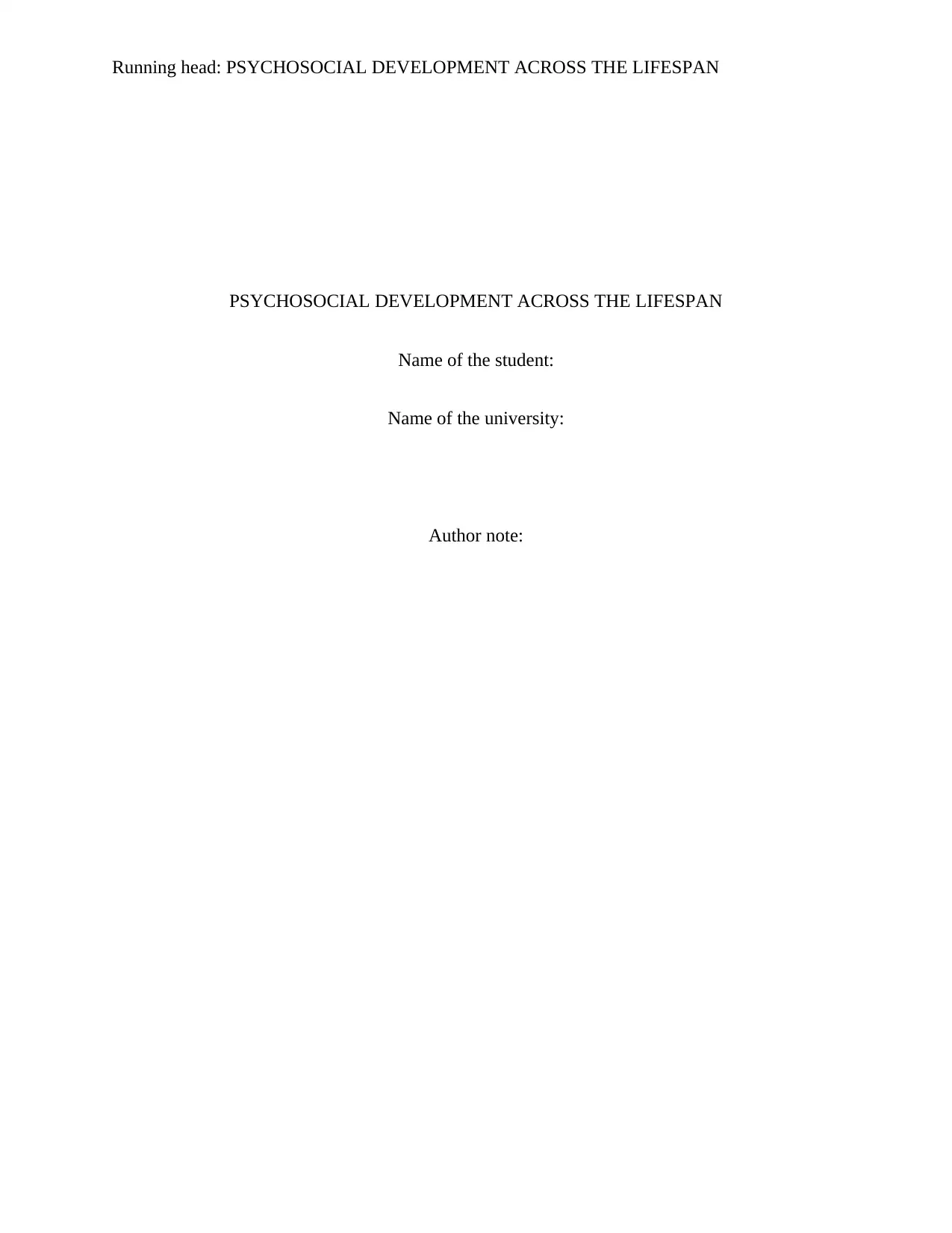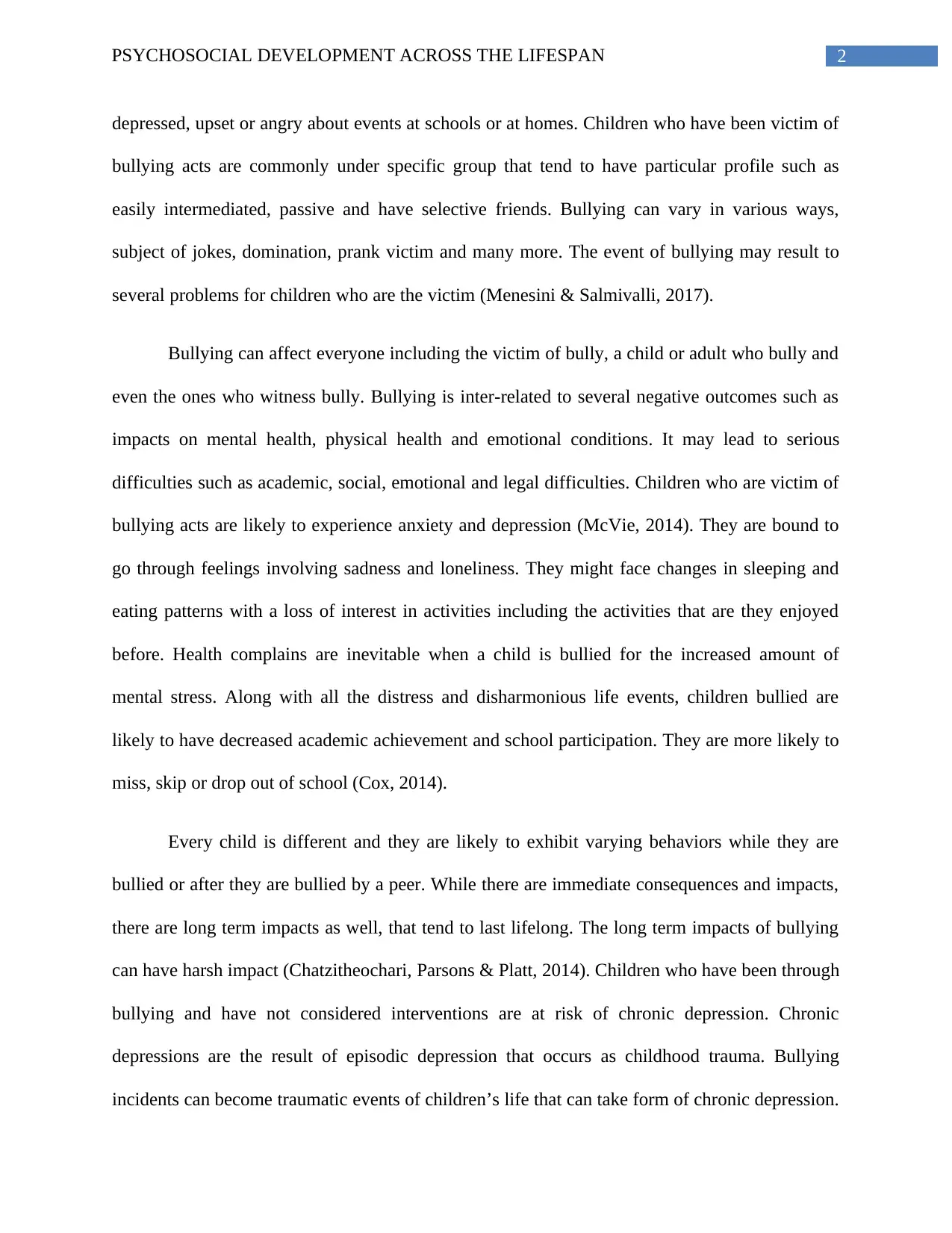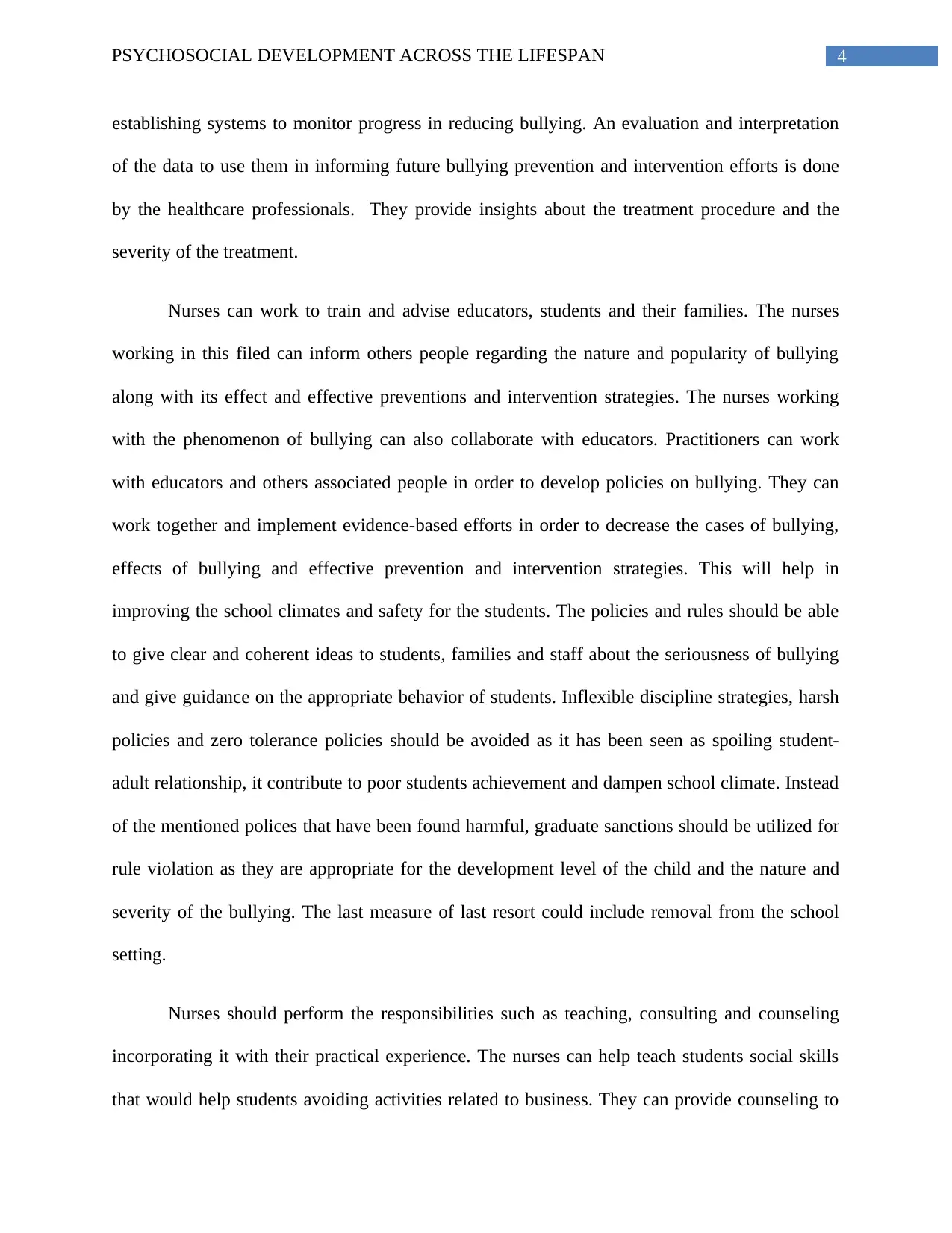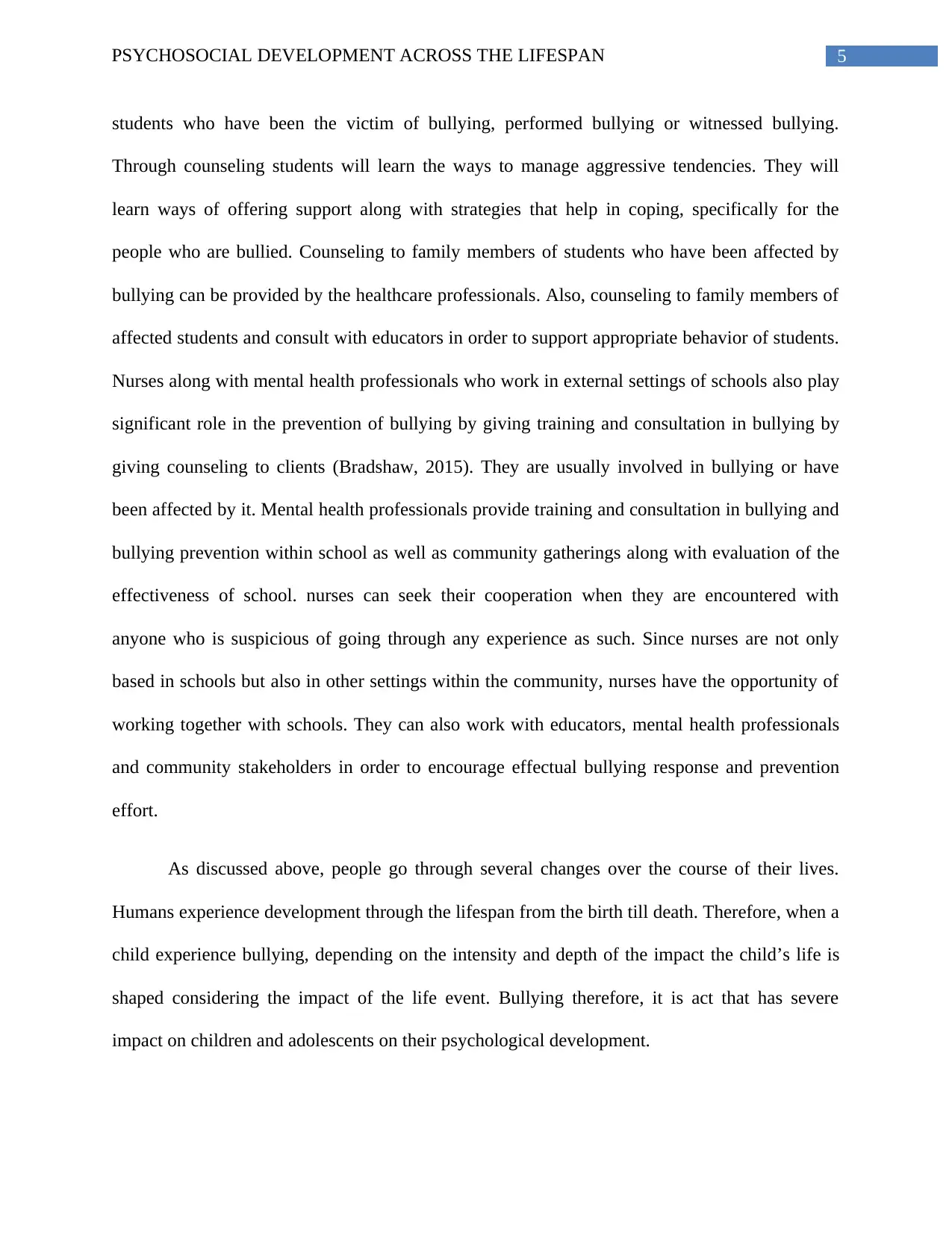1804NRS: Essay on Bullying, Psychosocial Development in Adolescence
VerifiedAdded on 2023/01/18
|7
|2091
|45
Essay
AI Summary
This essay delves into the significant impact of bullying on psychosocial development during adolescence (ages 11-20). It explores how bullying, whether physical, verbal, or online, can severely affect a child's social, emotional, and academic well-being, potentially leading to anxiety, depression, and even suicidal thoughts. The essay highlights the long-term consequences of bullying, including chronic depression, anxiety disorders, and difficulties in forming relationships. Furthermore, it emphasizes the crucial role of health professionals, particularly nurses, in addressing and preventing bullying. Nurses are equipped to collect data, train educators, counsel students and families, and collaborate with mental health professionals and community stakeholders to promote well-being and minimize the harm caused by bullying. The essay underscores the importance of nurses implementing evidence-based practices, developing effective policies, and providing support to all those affected by bullying, thereby creating safer and more supportive environments for adolescents.

Running head: PSYCHOSOCIAL DEVELOPMENT ACROSS THE LIFESPAN
PSYCHOSOCIAL DEVELOPMENT ACROSS THE LIFESPAN
Name of the student:
Name of the university:
Author note:
PSYCHOSOCIAL DEVELOPMENT ACROSS THE LIFESPAN
Name of the student:
Name of the university:
Author note:
Paraphrase This Document
Need a fresh take? Get an instant paraphrase of this document with our AI Paraphraser

1PSYCHOSOCIAL DEVELOPMENT ACROSS THE LIFESPAN
Children go through several changes over the course of their lives. Humans experience
development through the lifespan from the birth till death. For years psychologists strive to
understand and explain the ways and the reasons people change throughout life (Katz, Lazarsfeld
& Roper, 2017). There are changes that are considered normal and they are expected changes in
the human life. However there are changes that still pose challenges that people sometimes need
extra assistance to manage. The paper aims to discuss the ways an experience impact
psychological development during that particular period of the lifespan. By considering bulling
in Adolescence between the ages of 11-20 years, the paper will discuss the above concern and
the ways relevant health professionals can promote well-being and minimize harm that is caused
to individuals who are impacted by the experience. The essay will include an description of the
experience, impacts of the psychosocial development in that particular period of life followed by
the ways health professionals can promote wellbeing and minimize the harm.
One of the common phenomenons found in school setting that many children and
adolescents come across is bullying mostly during 11 to 20 years. According to survey, as many
as half of all children experience bullying at some point of time during their school years and at
least 10 per cent are bulled on a regular basis. Bullying is a behavior that can be physical or
verbal. While boys tend to use more physical intimidation, girls tend to use more verbal bullying
(Juvonen & Graham, 2014). Bullying is also found in online platforms such as social media, and
email and on social networking sites. Children are bullied go through real suffering that can have
strong impact on their social and emotional development along with a major impact on their
school performance. Bullying can even lead students or children attempt to suicide rather than
enduring such harassment and punishment. Often children who have been bullied are the ones
who tend to bully other children. Children and adolescents who are bullied may also be
Children go through several changes over the course of their lives. Humans experience
development through the lifespan from the birth till death. For years psychologists strive to
understand and explain the ways and the reasons people change throughout life (Katz, Lazarsfeld
& Roper, 2017). There are changes that are considered normal and they are expected changes in
the human life. However there are changes that still pose challenges that people sometimes need
extra assistance to manage. The paper aims to discuss the ways an experience impact
psychological development during that particular period of the lifespan. By considering bulling
in Adolescence between the ages of 11-20 years, the paper will discuss the above concern and
the ways relevant health professionals can promote well-being and minimize harm that is caused
to individuals who are impacted by the experience. The essay will include an description of the
experience, impacts of the psychosocial development in that particular period of life followed by
the ways health professionals can promote wellbeing and minimize the harm.
One of the common phenomenons found in school setting that many children and
adolescents come across is bullying mostly during 11 to 20 years. According to survey, as many
as half of all children experience bullying at some point of time during their school years and at
least 10 per cent are bulled on a regular basis. Bullying is a behavior that can be physical or
verbal. While boys tend to use more physical intimidation, girls tend to use more verbal bullying
(Juvonen & Graham, 2014). Bullying is also found in online platforms such as social media, and
email and on social networking sites. Children are bullied go through real suffering that can have
strong impact on their social and emotional development along with a major impact on their
school performance. Bullying can even lead students or children attempt to suicide rather than
enduring such harassment and punishment. Often children who have been bullied are the ones
who tend to bully other children. Children and adolescents who are bullied may also be

2PSYCHOSOCIAL DEVELOPMENT ACROSS THE LIFESPAN
depressed, upset or angry about events at schools or at homes. Children who have been victim of
bullying acts are commonly under specific group that tend to have particular profile such as
easily intermediated, passive and have selective friends. Bullying can vary in various ways,
subject of jokes, domination, prank victim and many more. The event of bullying may result to
several problems for children who are the victim (Menesini & Salmivalli, 2017).
Bullying can affect everyone including the victim of bully, a child or adult who bully and
even the ones who witness bully. Bullying is inter-related to several negative outcomes such as
impacts on mental health, physical health and emotional conditions. It may lead to serious
difficulties such as academic, social, emotional and legal difficulties. Children who are victim of
bullying acts are likely to experience anxiety and depression (McVie, 2014). They are bound to
go through feelings involving sadness and loneliness. They might face changes in sleeping and
eating patterns with a loss of interest in activities including the activities that are they enjoyed
before. Health complains are inevitable when a child is bullied for the increased amount of
mental stress. Along with all the distress and disharmonious life events, children bullied are
likely to have decreased academic achievement and school participation. They are more likely to
miss, skip or drop out of school (Cox, 2014).
Every child is different and they are likely to exhibit varying behaviors while they are
bullied or after they are bullied by a peer. While there are immediate consequences and impacts,
there are long term impacts as well, that tend to last lifelong. The long term impacts of bullying
can have harsh impact (Chatzitheochari, Parsons & Platt, 2014). Children who have been through
bullying and have not considered interventions are at risk of chronic depression. Chronic
depressions are the result of episodic depression that occurs as childhood trauma. Bullying
incidents can become traumatic events of children’s life that can take form of chronic depression.
depressed, upset or angry about events at schools or at homes. Children who have been victim of
bullying acts are commonly under specific group that tend to have particular profile such as
easily intermediated, passive and have selective friends. Bullying can vary in various ways,
subject of jokes, domination, prank victim and many more. The event of bullying may result to
several problems for children who are the victim (Menesini & Salmivalli, 2017).
Bullying can affect everyone including the victim of bully, a child or adult who bully and
even the ones who witness bully. Bullying is inter-related to several negative outcomes such as
impacts on mental health, physical health and emotional conditions. It may lead to serious
difficulties such as academic, social, emotional and legal difficulties. Children who are victim of
bullying acts are likely to experience anxiety and depression (McVie, 2014). They are bound to
go through feelings involving sadness and loneliness. They might face changes in sleeping and
eating patterns with a loss of interest in activities including the activities that are they enjoyed
before. Health complains are inevitable when a child is bullied for the increased amount of
mental stress. Along with all the distress and disharmonious life events, children bullied are
likely to have decreased academic achievement and school participation. They are more likely to
miss, skip or drop out of school (Cox, 2014).
Every child is different and they are likely to exhibit varying behaviors while they are
bullied or after they are bullied by a peer. While there are immediate consequences and impacts,
there are long term impacts as well, that tend to last lifelong. The long term impacts of bullying
can have harsh impact (Chatzitheochari, Parsons & Platt, 2014). Children who have been through
bullying and have not considered interventions are at risk of chronic depression. Chronic
depressions are the result of episodic depression that occurs as childhood trauma. Bullying
incidents can become traumatic events of children’s life that can take form of chronic depression.
⊘ This is a preview!⊘
Do you want full access?
Subscribe today to unlock all pages.

Trusted by 1+ million students worldwide

3PSYCHOSOCIAL DEVELOPMENT ACROSS THE LIFESPAN
Chronic depression lasts longer and tends to be more severe than episodic depression with
intensive treatment. Increased risk of suicidal thoughts, suicide plans and suicide attempts are
common for people who have been bullied in their childhood. These children are likely to have
anxiety disorder as well. Also, post-traumatic stress disorder is a form of psychological disorder
that is found among people associated with the act of bullying. Along with the mentioned
psychological issues, the impact of bullying in childhood and adolescents on future
psychological development involve self-destructive behavior, self-harm behavior, substance
abuse and poor general health. They find it hard to trust people or any other relationships. They
are less likely to be educated or employed for anxiety or anxious behavior (Trépanier, Fernet &
Austin, 2015).
Nurses are aware of the both community and school based conditions that may occur.
They are aware of the harsh impacts on the children and adolescents who have been directly
involved in the bullying other children and adults or even witnessed any events of bullying.
Nurses play important role in preventing and responding to people’s reaction to bullying. Since
nurses are having experience with the victims of the act of bullying they can use their experience
in spreading awareness. People go through several changes over the course of their lives.
Humans experience development through the lifespan from the birth till death. Nurses are the
some of the specialized professional who work in order to promote well-being and minimize
harm caused to the children associated with bullying. The ways nurses act with the people
associated with the act of bullying are in various ways.
One of the ways nurses work in association with the act of bullying is through collecting
data and use the data to inform prevention effort. Nurses can conduct assessments within the
schools, in order to identify evidence-based practices. These would involve addressing bullying,
Chronic depression lasts longer and tends to be more severe than episodic depression with
intensive treatment. Increased risk of suicidal thoughts, suicide plans and suicide attempts are
common for people who have been bullied in their childhood. These children are likely to have
anxiety disorder as well. Also, post-traumatic stress disorder is a form of psychological disorder
that is found among people associated with the act of bullying. Along with the mentioned
psychological issues, the impact of bullying in childhood and adolescents on future
psychological development involve self-destructive behavior, self-harm behavior, substance
abuse and poor general health. They find it hard to trust people or any other relationships. They
are less likely to be educated or employed for anxiety or anxious behavior (Trépanier, Fernet &
Austin, 2015).
Nurses are aware of the both community and school based conditions that may occur.
They are aware of the harsh impacts on the children and adolescents who have been directly
involved in the bullying other children and adults or even witnessed any events of bullying.
Nurses play important role in preventing and responding to people’s reaction to bullying. Since
nurses are having experience with the victims of the act of bullying they can use their experience
in spreading awareness. People go through several changes over the course of their lives.
Humans experience development through the lifespan from the birth till death. Nurses are the
some of the specialized professional who work in order to promote well-being and minimize
harm caused to the children associated with bullying. The ways nurses act with the people
associated with the act of bullying are in various ways.
One of the ways nurses work in association with the act of bullying is through collecting
data and use the data to inform prevention effort. Nurses can conduct assessments within the
schools, in order to identify evidence-based practices. These would involve addressing bullying,
Paraphrase This Document
Need a fresh take? Get an instant paraphrase of this document with our AI Paraphraser

4PSYCHOSOCIAL DEVELOPMENT ACROSS THE LIFESPAN
establishing systems to monitor progress in reducing bullying. An evaluation and interpretation
of the data to use them in informing future bullying prevention and intervention efforts is done
by the healthcare professionals. They provide insights about the treatment procedure and the
severity of the treatment.
Nurses can work to train and advise educators, students and their families. The nurses
working in this filed can inform others people regarding the nature and popularity of bullying
along with its effect and effective preventions and intervention strategies. The nurses working
with the phenomenon of bullying can also collaborate with educators. Practitioners can work
with educators and others associated people in order to develop policies on bullying. They can
work together and implement evidence-based efforts in order to decrease the cases of bullying,
effects of bullying and effective prevention and intervention strategies. This will help in
improving the school climates and safety for the students. The policies and rules should be able
to give clear and coherent ideas to students, families and staff about the seriousness of bullying
and give guidance on the appropriate behavior of students. Inflexible discipline strategies, harsh
policies and zero tolerance policies should be avoided as it has been seen as spoiling student-
adult relationship, it contribute to poor students achievement and dampen school climate. Instead
of the mentioned polices that have been found harmful, graduate sanctions should be utilized for
rule violation as they are appropriate for the development level of the child and the nature and
severity of the bullying. The last measure of last resort could include removal from the school
setting.
Nurses should perform the responsibilities such as teaching, consulting and counseling
incorporating it with their practical experience. The nurses can help teach students social skills
that would help students avoiding activities related to business. They can provide counseling to
establishing systems to monitor progress in reducing bullying. An evaluation and interpretation
of the data to use them in informing future bullying prevention and intervention efforts is done
by the healthcare professionals. They provide insights about the treatment procedure and the
severity of the treatment.
Nurses can work to train and advise educators, students and their families. The nurses
working in this filed can inform others people regarding the nature and popularity of bullying
along with its effect and effective preventions and intervention strategies. The nurses working
with the phenomenon of bullying can also collaborate with educators. Practitioners can work
with educators and others associated people in order to develop policies on bullying. They can
work together and implement evidence-based efforts in order to decrease the cases of bullying,
effects of bullying and effective prevention and intervention strategies. This will help in
improving the school climates and safety for the students. The policies and rules should be able
to give clear and coherent ideas to students, families and staff about the seriousness of bullying
and give guidance on the appropriate behavior of students. Inflexible discipline strategies, harsh
policies and zero tolerance policies should be avoided as it has been seen as spoiling student-
adult relationship, it contribute to poor students achievement and dampen school climate. Instead
of the mentioned polices that have been found harmful, graduate sanctions should be utilized for
rule violation as they are appropriate for the development level of the child and the nature and
severity of the bullying. The last measure of last resort could include removal from the school
setting.
Nurses should perform the responsibilities such as teaching, consulting and counseling
incorporating it with their practical experience. The nurses can help teach students social skills
that would help students avoiding activities related to business. They can provide counseling to

5PSYCHOSOCIAL DEVELOPMENT ACROSS THE LIFESPAN
students who have been the victim of bullying, performed bullying or witnessed bullying.
Through counseling students will learn the ways to manage aggressive tendencies. They will
learn ways of offering support along with strategies that help in coping, specifically for the
people who are bullied. Counseling to family members of students who have been affected by
bullying can be provided by the healthcare professionals. Also, counseling to family members of
affected students and consult with educators in order to support appropriate behavior of students.
Nurses along with mental health professionals who work in external settings of schools also play
significant role in the prevention of bullying by giving training and consultation in bullying by
giving counseling to clients (Bradshaw, 2015). They are usually involved in bullying or have
been affected by it. Mental health professionals provide training and consultation in bullying and
bullying prevention within school as well as community gatherings along with evaluation of the
effectiveness of school. nurses can seek their cooperation when they are encountered with
anyone who is suspicious of going through any experience as such. Since nurses are not only
based in schools but also in other settings within the community, nurses have the opportunity of
working together with schools. They can also work with educators, mental health professionals
and community stakeholders in order to encourage effectual bullying response and prevention
effort.
As discussed above, people go through several changes over the course of their lives.
Humans experience development through the lifespan from the birth till death. Therefore, when a
child experience bullying, depending on the intensity and depth of the impact the child’s life is
shaped considering the impact of the life event. Bullying therefore, it is act that has severe
impact on children and adolescents on their psychological development.
students who have been the victim of bullying, performed bullying or witnessed bullying.
Through counseling students will learn the ways to manage aggressive tendencies. They will
learn ways of offering support along with strategies that help in coping, specifically for the
people who are bullied. Counseling to family members of students who have been affected by
bullying can be provided by the healthcare professionals. Also, counseling to family members of
affected students and consult with educators in order to support appropriate behavior of students.
Nurses along with mental health professionals who work in external settings of schools also play
significant role in the prevention of bullying by giving training and consultation in bullying by
giving counseling to clients (Bradshaw, 2015). They are usually involved in bullying or have
been affected by it. Mental health professionals provide training and consultation in bullying and
bullying prevention within school as well as community gatherings along with evaluation of the
effectiveness of school. nurses can seek their cooperation when they are encountered with
anyone who is suspicious of going through any experience as such. Since nurses are not only
based in schools but also in other settings within the community, nurses have the opportunity of
working together with schools. They can also work with educators, mental health professionals
and community stakeholders in order to encourage effectual bullying response and prevention
effort.
As discussed above, people go through several changes over the course of their lives.
Humans experience development through the lifespan from the birth till death. Therefore, when a
child experience bullying, depending on the intensity and depth of the impact the child’s life is
shaped considering the impact of the life event. Bullying therefore, it is act that has severe
impact on children and adolescents on their psychological development.
⊘ This is a preview!⊘
Do you want full access?
Subscribe today to unlock all pages.

Trusted by 1+ million students worldwide

6PSYCHOSOCIAL DEVELOPMENT ACROSS THE LIFESPAN
Referencing:
Bradshaw, C. P. (2015). Translating research to practice in bullying prevention. American
Psychologist, 70(4), 322.
Chatzitheochari, S., Parsons, S., & Platt, L. (2014). Bullying experiences among disabled
children and young people in England: Evidence from two longitudinal
studies. Department of Quantitative Social Science UUorking Paper, (14-11).
Cox, A. K. (2014). Bullying. The Encyclopedia of Criminology and Criminal Justice, 1-3.
Juvonen, J., & Graham, S. (2014). Bullying in schools: The power of bullies and the plight of
victims. Annual review of psychology, 65, 159-185.
Katz, E., Lazarsfeld, P. F., & Roper, E. (2017). Personal influence: The part played by people in
the flow of mass communications. Routledge.
McVie, S. (2014). The impact of bullying perpetration and victimization on later violence and
psychological distress: a study of resilience among a Scottish youth cohort. Journal of
school violence, 13(1), 39-58.
Menesini, E., & Salmivalli, C. (2017). Bullying in schools: the state of knowledge and effective
interventions. Psychology, health & medicine, 22(sup1), 240-253.
Trépanier, S. G., Fernet, C., & Austin, S. (2015). A longitudinal investigation of workplace
bullying, basic need satisfaction, and employee functioning. Journal of occupational
health psychology, 20(1), 105.
Referencing:
Bradshaw, C. P. (2015). Translating research to practice in bullying prevention. American
Psychologist, 70(4), 322.
Chatzitheochari, S., Parsons, S., & Platt, L. (2014). Bullying experiences among disabled
children and young people in England: Evidence from two longitudinal
studies. Department of Quantitative Social Science UUorking Paper, (14-11).
Cox, A. K. (2014). Bullying. The Encyclopedia of Criminology and Criminal Justice, 1-3.
Juvonen, J., & Graham, S. (2014). Bullying in schools: The power of bullies and the plight of
victims. Annual review of psychology, 65, 159-185.
Katz, E., Lazarsfeld, P. F., & Roper, E. (2017). Personal influence: The part played by people in
the flow of mass communications. Routledge.
McVie, S. (2014). The impact of bullying perpetration and victimization on later violence and
psychological distress: a study of resilience among a Scottish youth cohort. Journal of
school violence, 13(1), 39-58.
Menesini, E., & Salmivalli, C. (2017). Bullying in schools: the state of knowledge and effective
interventions. Psychology, health & medicine, 22(sup1), 240-253.
Trépanier, S. G., Fernet, C., & Austin, S. (2015). A longitudinal investigation of workplace
bullying, basic need satisfaction, and employee functioning. Journal of occupational
health psychology, 20(1), 105.
1 out of 7
Related Documents
Your All-in-One AI-Powered Toolkit for Academic Success.
+13062052269
info@desklib.com
Available 24*7 on WhatsApp / Email
![[object Object]](/_next/static/media/star-bottom.7253800d.svg)
Unlock your academic potential
Copyright © 2020–2025 A2Z Services. All Rights Reserved. Developed and managed by ZUCOL.





